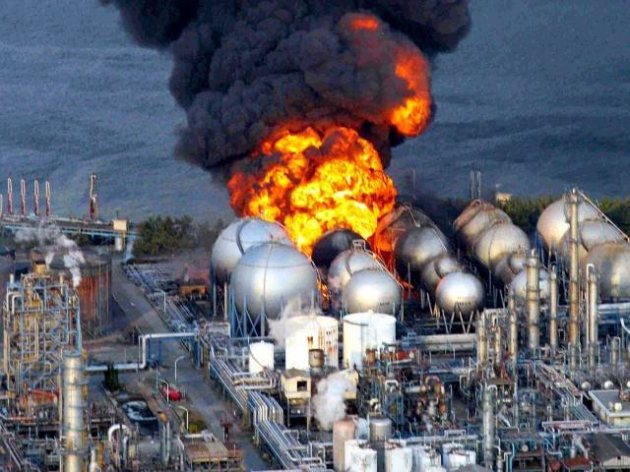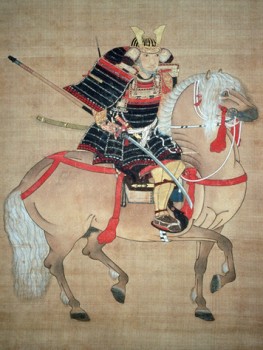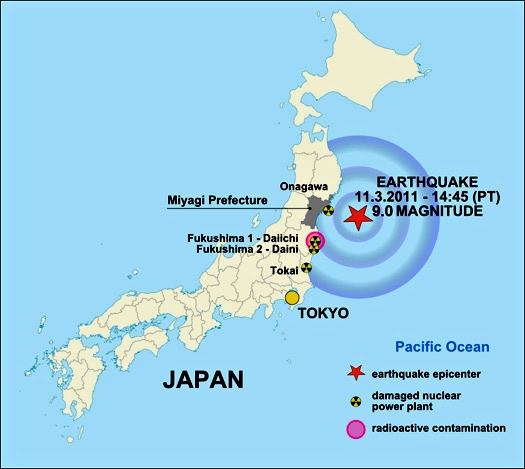Note: Sacred Cesium Ground is published with a companion novella, Isa’s Deluge, as part of the Weatherhead Books on Asia series by Columbia University Press. Isa’s Deluge is reviewed following this review of Sacred Cesium Ground.
“I took only my phone and lip cream; my wallet and cosmetic bag stayed in the car; I couldn’t imagine I would need them anytime soon. One thing was still bothering me: do I take the Geiger counter?…It had been bad enough on the road from the hotel, but it was now ringing with a frequency I hadn’t heard before…ten times over the official level that would require Decontamination Implementation Protocols; forty times higher than the measurements I got when I lived in Nakano, in Tokyo….” – main character Hiromi.
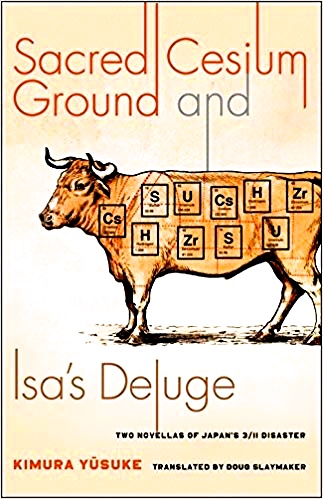 On March 11, 2011, the most powerful earthquake in Japanese history, registering 9.0 on the Richter scale, hit northeast Japan, killing sixteen thousand people and creating massive devastation. The powerful tsunami that resulted from this earthquake obliterated towns along the coast, and was so powerful it would go on to affect even the coasts of North and South America. Most terrifying, the rush of sea water had the immediate effect of creating meltdowns at all three reactors at the Fukushima Daiichi Nuclear Power Plant, which then released horrific amounts of radioactivity into the atmosphere and precipitated the evacuation of over three hundred thousand people. With a succession of disasters like these – a powerful earthquake, a tsunami, and a nuclear disaster – and all the cleanup and social management involving the population of the area, life in the Fukushima area was frantic – people displaced, many deaths, families torn apart, livelihoods gone, and the earth itself contaminated. In the eight years since then, life has been in “emergency mode,” with so much of immediate importance being faced every day by the people of the area that few former residents, service organizations, or concerned citizens have been able to go there, stand back, and see the results of this emergency in any kind of universal perspective.
On March 11, 2011, the most powerful earthquake in Japanese history, registering 9.0 on the Richter scale, hit northeast Japan, killing sixteen thousand people and creating massive devastation. The powerful tsunami that resulted from this earthquake obliterated towns along the coast, and was so powerful it would go on to affect even the coasts of North and South America. Most terrifying, the rush of sea water had the immediate effect of creating meltdowns at all three reactors at the Fukushima Daiichi Nuclear Power Plant, which then released horrific amounts of radioactivity into the atmosphere and precipitated the evacuation of over three hundred thousand people. With a succession of disasters like these – a powerful earthquake, a tsunami, and a nuclear disaster – and all the cleanup and social management involving the population of the area, life in the Fukushima area was frantic – people displaced, many deaths, families torn apart, livelihoods gone, and the earth itself contaminated. In the eight years since then, life has been in “emergency mode,” with so much of immediate importance being faced every day by the people of the area that few former residents, service organizations, or concerned citizens have been able to go there, stand back, and see the results of this emergency in any kind of universal perspective.
Until now. With Sacred Cesium Ground, author Yusuke Kimura* has created a novella which is truly unique – literally one of a kind – a work so transcendent that it is hard to imagine anyone reading it who will not be moved by the experience and changed by the insights into this nuclear disaster in a rural area in which many farmers have traditionally raised cattle. When these farmers were suddenly evacuated from their irradiated fields and farms, the cattle and other farm animals remained behind. For the evacuated residents, the loss was not only financial but also personal, as most of them respected their animals, even though the animals were, ironically, being raised for slaughter. Sacred Cesium Ground opens with Hiromi, a troubled young woman in an abusive marriage who appears at the “Fortress of Hope,” a rural sanctuary for abandoned farm animals on the contaminated, evacuated land.
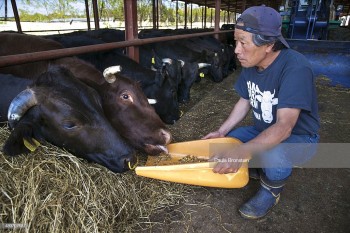
Farmer Masami Yoshizawa feeds his cattle, much as Sendo does in this novella. Getty image by Paula Bronstein.
Coming from the Tokyo area, Hiromi arrives at the animal refuge/farm as a volunteer worker for the weekend, along with a handful of other citizens and a few full-time workers who live there. The work is difficult, the supplies for feeding the animals are sometimes spoiled, the weather is challenging, and the ever-present danger of personal contamination by radiation is absolute. The connection between the animals, who are the incidental victims of humans; the obligations, if any, of the humans towards them; the resentment of these workers against what they regard as “inhuman” behavior on the part of their government towards the animals harmed; and the connections between the volunteers and the animals they help lead to a dramatic and sensitive epiphany on the part of at least one volunteer. The sensitive, often earthy, writing provides deeply felt commentary by the female visitor from the Tokyo area, and sets up contrasts so stark that many readers, like the visitor, will become completely wrapped up in the tragedy here. Ultimately, most readers, too, will see the totality of life in new ways in the aftermath of this disaster. Stunning.
Review of Isa’s Deluge by Yusuke Kimura
(ISBN 978-0231189439)“A low rumble reverberated from the ground…for as far as he could make out, rise in a wave, hollow into a trough, and then out of the resulting dust, sometimes a hand would emerge, sometimes a head, backs would rise, crowds of people would appear, all the way to the distant horizon. When they rose, brushed off the dust, and stood with confidence, they appeared to be warriors like you would see in ancient, Heian-Period scrolls. But, with pelts around their shoulders, there was also something barbarian about them.” – Shoji’s dream.
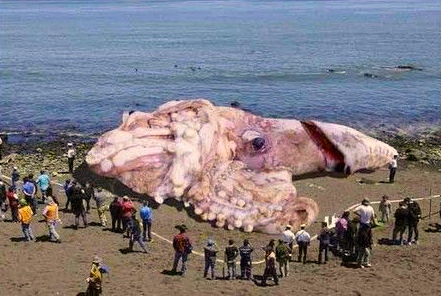
A Giant Squid, which came ashore in Japan, one which is undoubtedly larger than anything Shoji and Hitoshi ever saw, much less caught.
Less tightly focused and more specifically psychological than Sacred Cesium Ground, this novella opens with main character Shoji fishing for squid at night with his cousin Hitoshi. An “infinite number” of other boats hung with squid lures and lights are conjured up as Hitoshi begins telling the story of his Uncle Isa, one of a group of “tough fishermen,” a tale so romantically descriptive here that even Shoji suggests that Hitoshi may be “laying it on a little thick.” Both men have been drinking heavily, and Shoji is anxious to find out more about his Uncle Isa. Now forty, Shoji has come to Hachinohe from Tokyo because he is at a loss, personally. He knows that he has an “inability to adjust,” along with no money, no woman, no friends, no looks, and no people skills,” and that is just the beginning of his limitations.
Two months before the Great East Japan Earthquake, Shoji began having a recurring dream in which his Uncle Isa appeared. Uncle Isa may have committed “the darkest stain in Kawamura family lineage” by stabbing someone who taunted him, and he is regarded as an example of extreme manhood by Shoji and, to a lesser extent, by Hitoshi. As Shoji thinks about writing a story about Uncle Isa, his images of his own life, compared to the lives of the warriors and people of the Heian period who appear in his dreams, show him to be an almost laughably smaller and less significant person. Gradually, his own upbringing, compared to that of Uncle Isa and other members of his family, emerges, as do the current effects of the earthquake, the nuclear explosion, and the tsunami on the family he has in rural Japan. A school reunion and his own behavior during the evening eventually lead Shoji to some new awareness of just who Uncle Isa really is, both to Shoji and to those other family members who have known him.
Less tightly organized than Sacred Cesium Ground, this novella is also less specifically connected to the three great disasters experienced by the population of rural northeast Japan, and the irony of seeing Shoji’s personal problems in the same context as those horrific disasters may be part of the author’s point. Taken together, these two novellas offer unique views of the aftereffects of the disasters of 2011.
*NOTE: Translator Doug Slaymaker explains some of the challenges of this translation in an Afterword, and he does a masterful job of making the lives of the characters here seem real. My one difficulty is with the fact that the author’s name has not been translated into the customary pattern of Japanese names in English translations. Usually, including in all Wikipedia entries in English, a Japanese person’s family name appears last as it does in English, with the personal name given first (as in Junichiro Tanizaki, Haruki Murakami, Yukio Mishima, Kenzaburo Oe). In this translation, however, it is the Japanese name order which prevails for the author’s name (Kimura Yusuke), even in English. To keep this book consistent with all the other entries on this website, I have used the English name order in this review and in all the alphabetical listings.
Photos. The meltdown of three reactors of the Fukushima Nuclear Plant is found on http://gratisparacelular.blogspot.com/
Farmer Masami Yoshizawa feeds his cattle, much as Sendo does in this novella. Getty image by Paula Bronstein. https://www.gettyimages.ca/
A Giant Squid, which came ashore in Japan, one which is undoubtedly larger than anything Shoji and Hitoshi ever saw, much less caught. https://sociorocketnewsen.files.wordpress.com/
A Heian Dynasty Warrior, 794 – 1185, much like those that appear in some of Shoji’s dreams and offer themselves as role models. https://sites.google.com
Map of the area in which the earthquake, the tsunami, and the nuclear meltdown took place on March 11, 2011. http://www.bioedonline.org CLICK TO ENLARGE.
